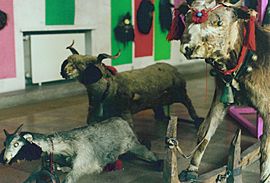The Goat and Her Three Kids facts for kids

"The Goat and Her Three Kids" or "The Goat with Three Kids" (Romanian: Capra cu trei iezi) is an 1875 short story, fable and fairy tale by Romanian author Ion Creangă. Figuratively illustrating for the notions of motherly love and childish disobedience, it recounts how a family of goats is ravaged by the Big Bad Wolf, allowed inside the secured home by the oldest, most ill-behaved and least prudent of the kids. The only one of the children to survive is the youngest and most obedient, who then helps his mother plan her revenge on the predator, leading to a dénouement in which the wolf is tricked and eventually dies.
Popularized by the Romanian curriculum and included in primers, Creangă's tale has endured as one of the best-known works in local children's literature. "The Goat and Her Three Kids" has also been the topic of several music, theater and film adaptations, in both Romania and Moldova.
Plot
The story opens with an introduction of its protagonists: the hardworking and widowed goat and her three kids, of whom the two older ones are misbehaved, while the youngest obeys his mother. On one day, the goat gathers all three around, telling them that she must leave on a quest for food, instructing them not to open the door unless they hear her singing, in characteristically soft voice, the refrain:
|
Trei iezi cucuieţi |
Three kids with growing horns, |
The conversation is overheard by the wolf, who spies on the goat's family. Although being a godfather to the kids (and therefore an in-law, cumătru, to the goat herself), the villain has his eye set on eating the goat's children. A while after the mother has left, the wolf sneaks in front of the door and starts singing her song to the three kids. The ruse succeeds in convincing the eldest two children, who rush in to open the door. They are stopped by the youngest, who notices that the song is performed in an unusually coarse voice.
Having heard this too, the Big Bad Wolf hurries over to a smith's shop, where he gets his tongue and teeth "sharpened". He then returns to the goat's house, and this time performs the song in a soft voice. The eldest kid ignores his youngest brother's advice for more caution, and rushes in to let the stranger in. Meanwhile, the other two hide around the house: the youngest by tunneling his way up the soot-filled chimney, the second-oldest by hiding under an overturned trough. As soon as he is in, the wolf kills the careless kid and eats him whole. This prompts the polite but imprudent kid hiding under the trough to speak up and wish him să-ţi fie de bine (roughly, "may it serve you"). As a result of this, the intruder is able to drag him out of his hiding place and gulp him down. After spending some time looking for the third kid, the wolf tires and, in what is intended as a humiliating gesture, stains the walls with the kids' blood and places their heads on the window sills, modifying their facial expression to seem like they are smiling.
The wolf eventually leaves, and the youngest kid emerges from the chimney unharmed. Initially deceived by the heads smiling at her as she enters the courtyard, the goat learns what happened from the youngest kid, and begins to plot her revenge. She soon afterward begins cooking a rich meal, and filling a large pit near her house with embers and slow-burning firewood. She covers the spot with thin layers of mats and earth, and places a stool made out of wax on top of these. The goat then walks into the forest and meets her cumătru, informing him that she has discovered his evil deed, but that she has moved on. She also asks the wolf to attend a traditional memorial service for the kids, back at her house. The villain agrees, and unwittingly takes his seat on the wax chair, which melts as he consumes meal after meal. Eventually, he falls into the pit and is engulfed by the flames. As he pleads for rescue, the goat informs him that she follows "the words of the scripture", or lex talionis, which she paraphrases as "a death for a death [and] a burn for a burn". The story ends as all goats in the area celebrate the death with an actual feast.
Film Adaptation
In 2019 the short film The Goat and Her Three Kids starring Maia Morgenstern and Marius Bodochi, directed by Victor Canache and produced by Luana Georgiţă premieres at Transilvania International Film Festival.
In an endeavor to unveil the true nature of the famed bed time story, the short film aims to treat the audience to a different perspective, one that offers a glimpse at what the mother’s tragedy actually looks like beyond the happy songs and colorful characters.

